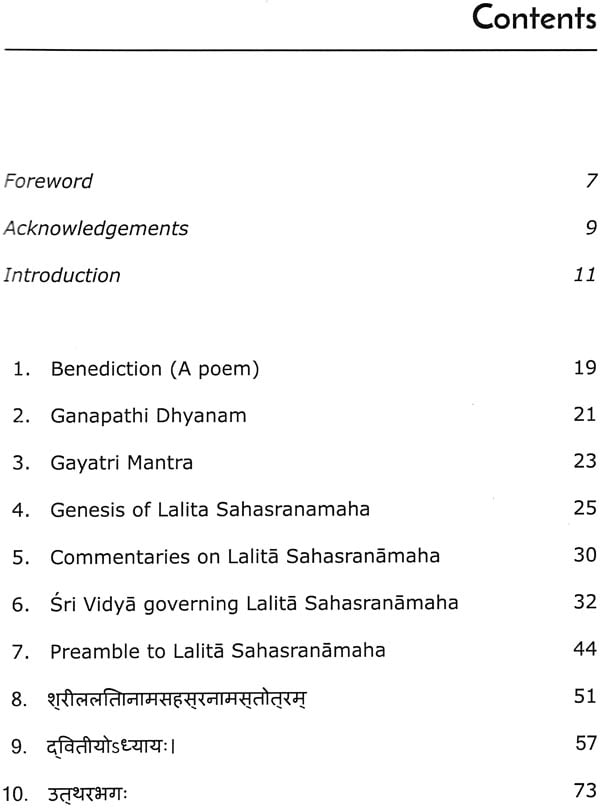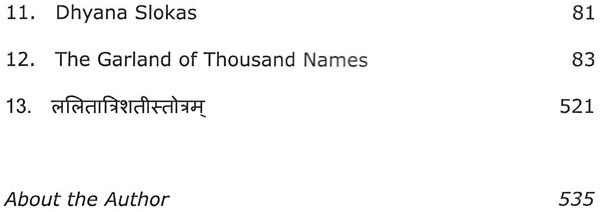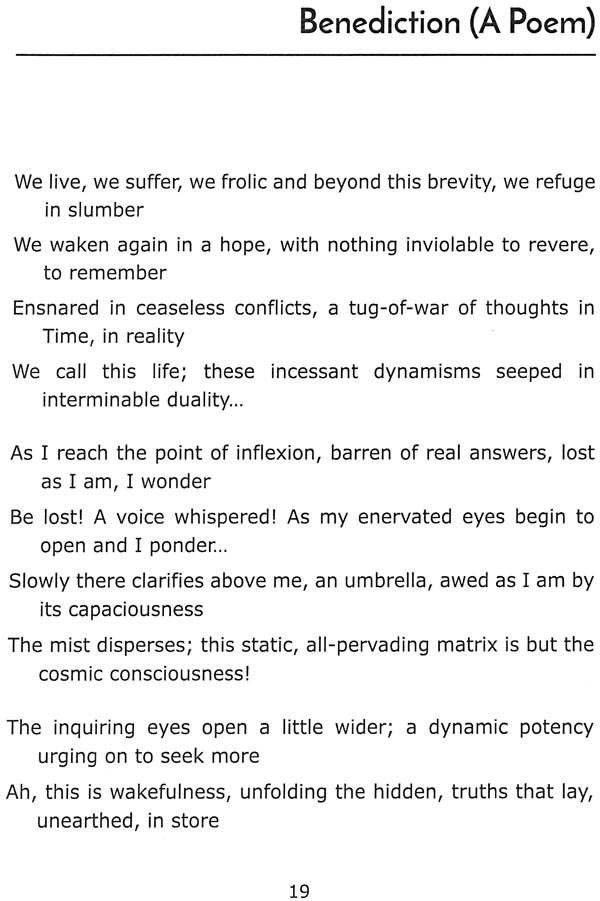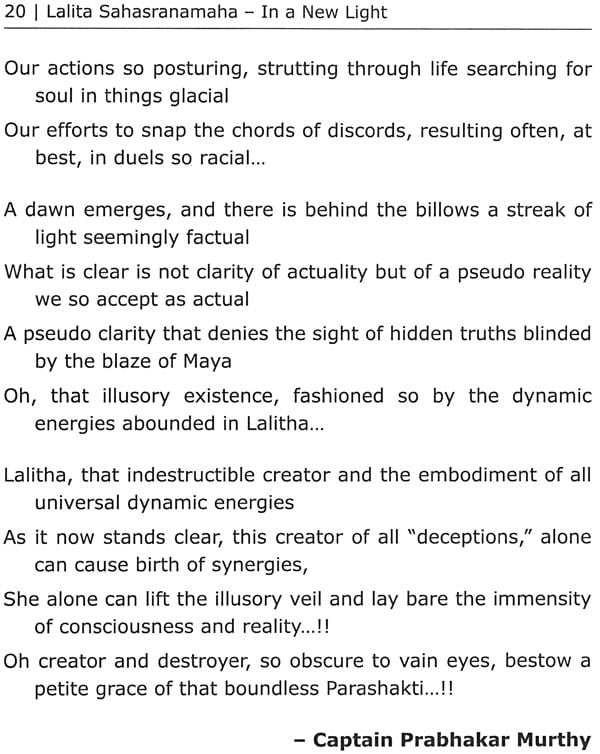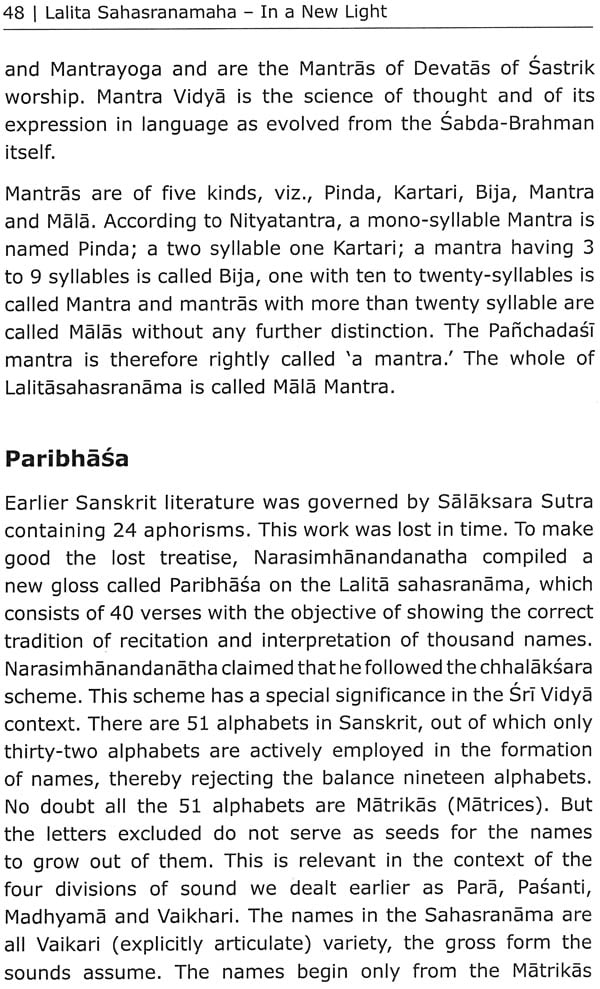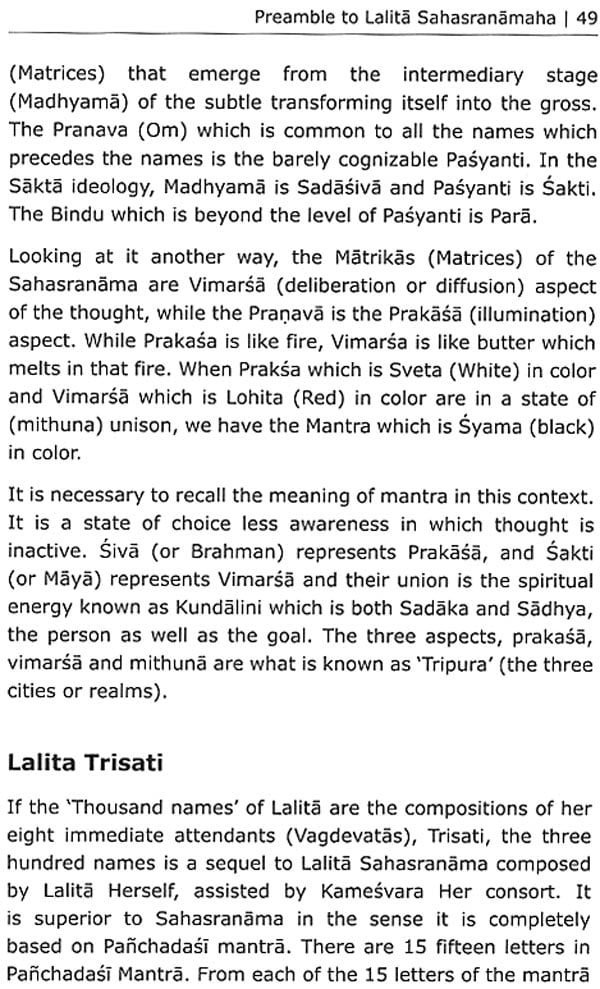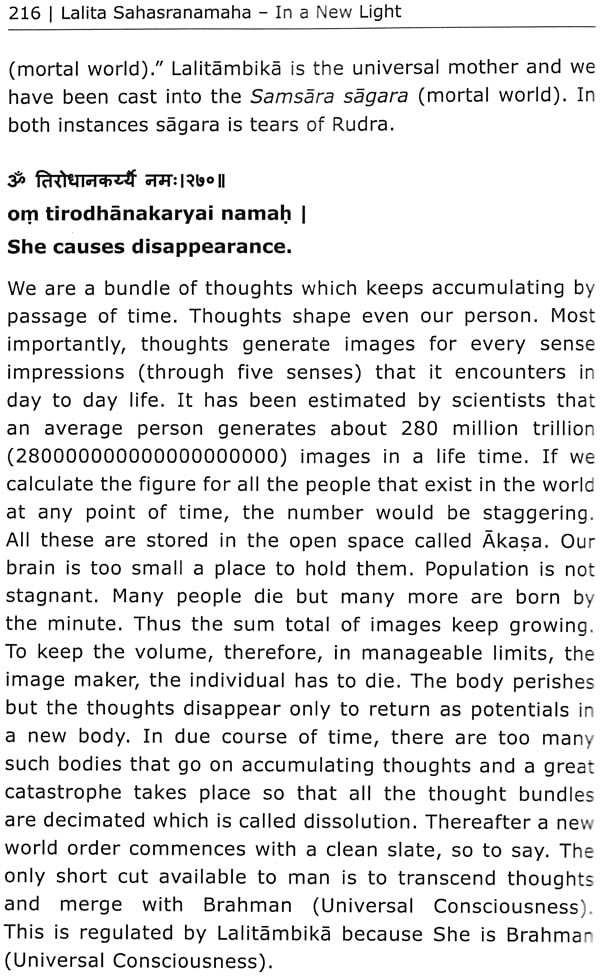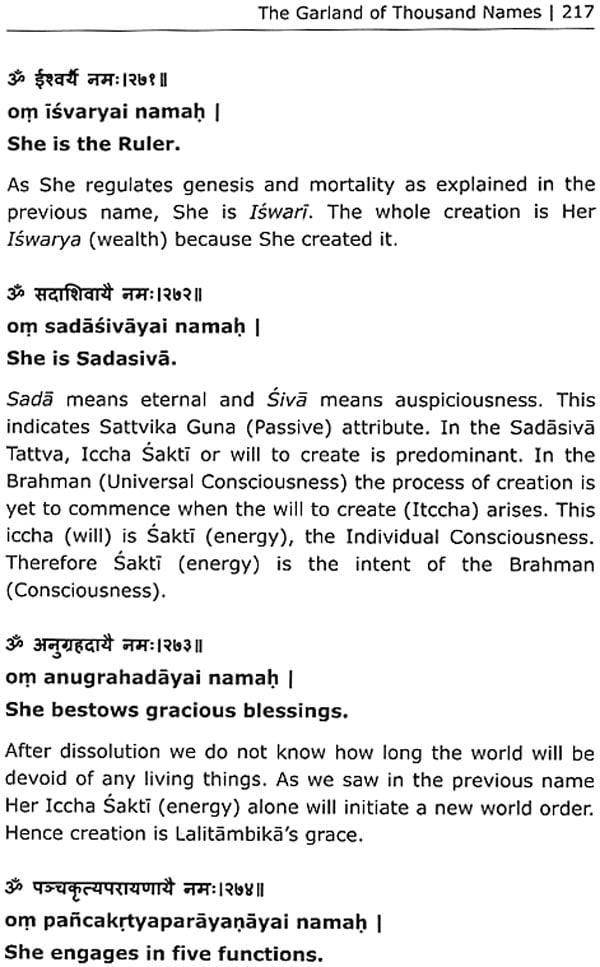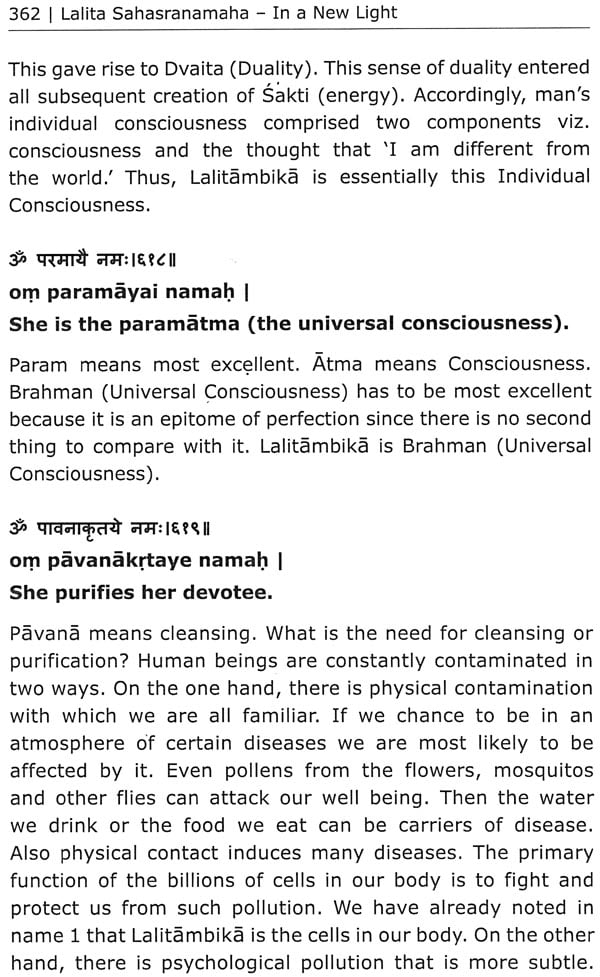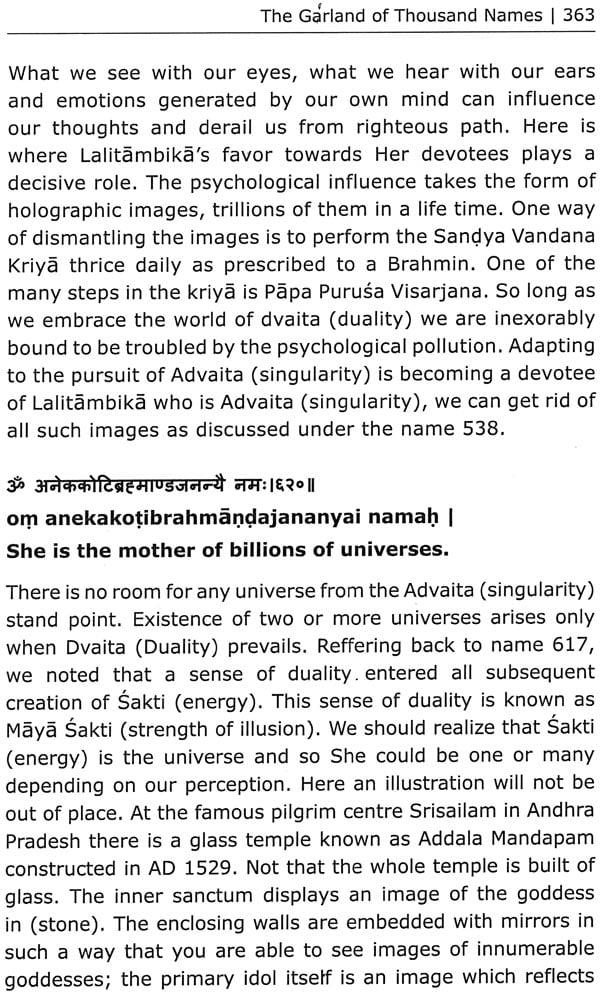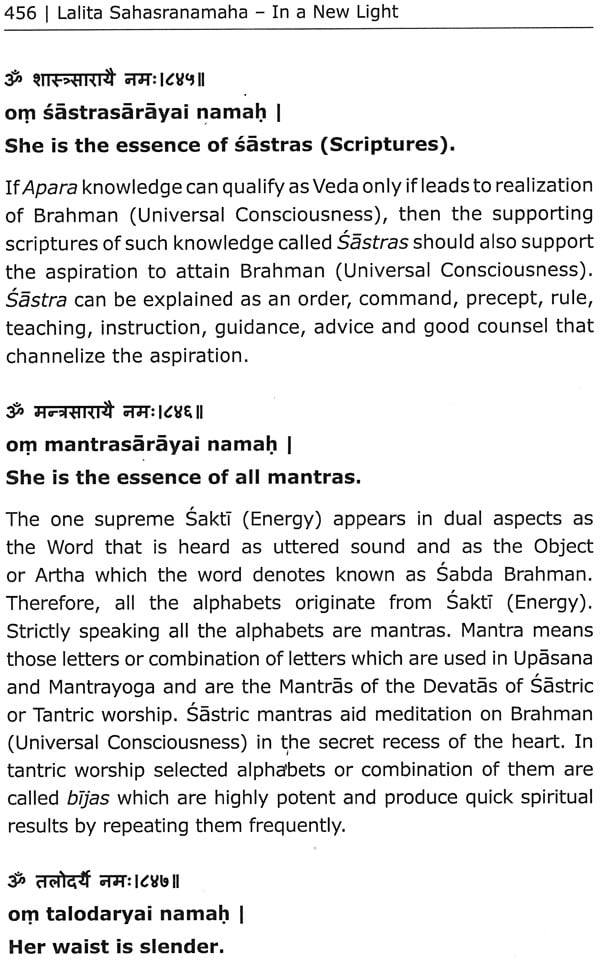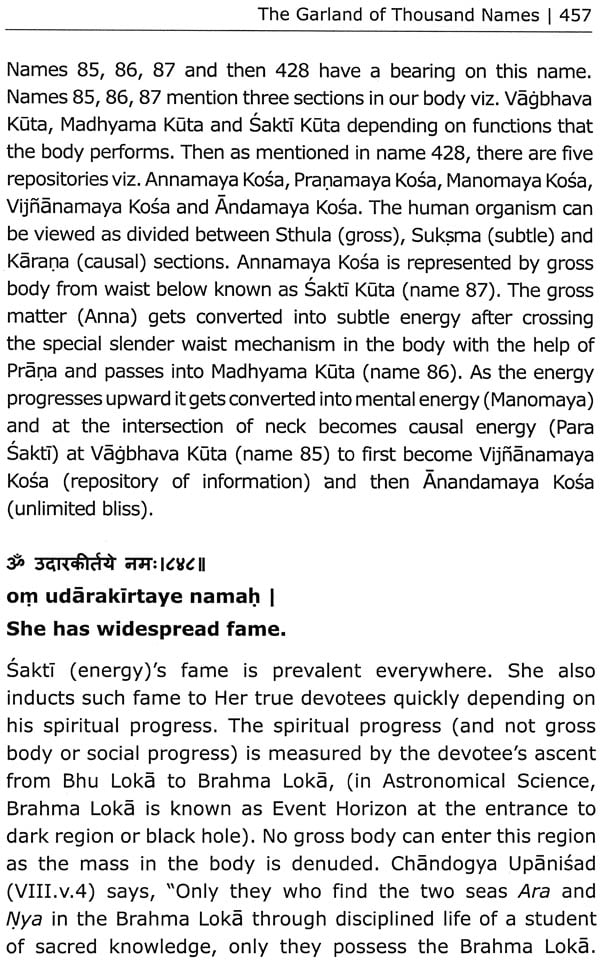
Lalita Sahasranamaha - In a New Light
Book Specification
| Item Code: | NAR150 |
| Author: | Choudur Satyanarayana Moorthy |
| Publisher: | Notion Press |
| Language: | English |
| Edition: | 2019 |
| ISBN: | 9781645466086 |
| Pages: | 536 (6 B/W & 2 Color Illustrations) |
| Cover: | PAPERBACK |
| Other Details | 9.00 X 6.00 inch |
| Weight | 680 gm |
Book Description
Indisputably, Gayatri’ is the greatest Mantra in the Vedas. It has been claimed that it is the quintessence of Vedas.
The Mantra means that there are three layers of existence and in all the layers, that sun Brahman (universal Consciousness) provides its effulgence. We are ordained to repeat this Mantra on every spiritual occasion so that we do not lose sight of the fact even for a moment.
In Bhu and Bhuvar Loka(layers) thought predominates pushing awareness to back-seat. Bhu is earth where we belong and Bhuvar Loka is the world of imagination that tethers us to Bhu (Loka). At Suvar Loka (layer), thought dissipates allowing unobstructed freedom of awareness. Predominance of thought implies duality (dvaita) as "I" am different for the world at large. As a consequence, thought creates a virtual reality commong to all beings. We know no other reality. When a spiritual aspirant transcends thought, he graduates into a world of awareness where true reality is revealed. Space and time cease.
That is the world of Lalitambika (Advaita). Most of the thousand names (Lalita Sahasranama) are relevant to a devotee who has transcended Bhu and Bhuvar Loka (layers) and set his focus on Suvar Loka with assistance from Lalitambika.
Mr. C S Moorthy was born in the year 1938 in Kanchipuram, Tamil Nadu, India. He grew up in Mumbai where he did his schooling. He obtained his Master's Degree in English from Mysore University. He was elected as a Member of Chartered Institute of Management Accountants, UK in May 1978. He retired as Chief Manager Finance at Southern Petrochemical Industries Corporation in 1998.
He came into close association with Late Swami Chinmayananda and was his ardent follower between the years 1959 and 1969. He was mentored by Swami Chinmayananda's then principle disciple Sri. Brahmachari Natarajan, who later on became Late Swami Dayananda Saraswati on his own right. He encouraged Sri C S Moorthy to read books by Late J. Krishamurti in 1970.
Since then Mr. Moorthy attended all the lectures (in Mumbai) of J. Krishamurti and became his great admirer till his death in 1986. Mr. Moorthy commenced his independent research on scientific and spiritual aspects of ancient scriptures. He published his first book "gleanings from Rig Veda-When Science was Religion in 2011, a concentrated extract of many years of avid thoughts, readings and his deep understanding of sacred scriptures compiled by Rishis.
Shakti is the creative power that resides inseparably with Shiva, who is the unborn, undying, unchanging Brahman or Consciousness principle - the purest essence of everything that is. Revelation of this ultimate truth is the intent and the content of the body of knowledge contained in the Veda which includes Puranic literature by reference. Shakti ramifies, proliferates and manifests as the perceptible pluralistic Universe, and is therefore characterized as female - Devi or the Divine Mother. A sincere enquiry into the nature of Devi, is therefore certain to bestow benediction upon the seeker of Truth and lead to the knowledge of Devi's abode, Devi's essence - the non-dual Brahman, Shiva.
The Lalitha Sahasranama or thousand names extolling the virtues and glories of the Divine Mother, occurs in the Brahmanda Purana, in the form of Upadesha or a teaching dialogue between Hayagriva - the qualified Guru and Sage Agastya the pure-minded student. The Lalitha Sahasranama contains the gist of the entire Brahma Vidya or knowledge of Brahman, that liberates an individual from his sense of limitation and fulfills his fundamental quest for peace and happiness.
In this book - Lalitha Sahasranama - In New Light, the author Shri C. Satyanarayana Moorthy, an acclaimed and renowned Vedic scholar, incorporates in his commentary, the meaning of each of the thousand names of Devi from an additional perspective of modern science. He has thereby established the eternal relevance of Lalitha Sahasranama for the benefit of this generation of millennials also. This book is the culmination of research and analysis of a broad spectrum of scriptural and scientific literature. It is worthy of a lifetime of repeated study by contemplating - a Nama a day - upon the import of the thousand names of the Divine Mother, akin, if you will, to consuming a daily spiritual multivitamin. The book is targeted toward all Mumukshus or seekers of the Truth and ensues with Devi's mandate and full grace.
My research into ancient Indian spiritual literature produced many surprises. It dawned on me that many facts seem to have escaped the attention of the scholarly class. Accordingly, basing on the oldest literary compilation in the whole world, The Rig Veda, I published my first book "Gleanings from Rig Veda-When Science was Religion." Surprisingly, modern science, which has been progressively developing science last 450 years, has confirmed many postulates of the ancient Rig Veda. There is however, a difference. Whereas the visions of the ancient Rishis were firm testimonials of the existence and interactions of the phenomena, findings of the modern science are tentative in discovering the same phenomena, though science has made tremendous progress in unveiling the secrets of nature in such a short time.
There was another great insight which the compilers of Rig Veda shared amongst themselves, which has been only partially explored by modern science to date. The ancients observed that thought distorts our perception of reality and there is a dire need to transcend thought to observe existence in its pristine glory. The ancient Rishis took steps to transcend thought. Instantly they became one with consciousness the prime cause of all phenomena including existence. They articulated their perception in the form of Mantras in their compilation called Rig Veda. It is common knowledge that there are four Vedas viz., Rig, Yajus, Sama and Atharva Veda. But looking at the composition of the compilations a different story emerges. Besides the Rig Veda which wholly comprises of Riks, out of the 700 verses in Yajur Veda, 581 mantras are Riks; out of 1875 verses in Sama Veda 1800 mantras are Riks and out of 7950 verses of Atharva Veda, 1260 mantras are Riks. Some authorities affirm that there are only three Vedas and do not accord vedic status to Atharva. This makes many authorities declare that a mention of Veda in any context refers to the Rig Veda alone.
Originally, Rig Veda consisted of 500500 mantras according to a research establishment in Kerala but what are now extant is only 10552 mantras. Even these fewer mantras enable us to realize how energy and forces regulate existence. My previous book mentioned above, dealt with various forces in nature. In this book we deal with energy the quintessence of existence. Energy is called Sakti in Sanskrit (name 217 in Sahasranama). All forces in nature are dependent on light (electromagnetic force) but energy is not dependent on anything (name 199 in Sahasranama), because it is an integral part of consciousness which is the very existence. Energy cannot be destroyed; it can only be stored; used; redirected and processed. For that reason alone, energy (Sakti) is called the Supreme Latitambikel who cannot be vanquished. To put it succinctly, Rig Veda is all about Consciousness and its ramification, and the word ramification in the phrase implies Lalitambika as we shall see in this treatise. Rig Veda is a grand eulogy of consciousness, and it also deals with energy (Sakti) in a pithy form in many mantras; more elaborately as yak and exclusively in Sri Sukta, a Khila Sukta or an appendix to Mandala 5. Some authorities hold that Mandala 5 of Rig Veda at Sukta 47 Mantra 4 hints at Sri Vidya, when it states:"That which contains four Ims and confers benefit," as this refers to the sixteen syllable Sodasi Mantra. Moreover, Tripuratapini Upanisad establishes a correspondence between Gayatri Mantra (Rig Veda 3-62-10) with the Pafichadai Mantra and that 'Tat' in Gayatri Mantra is synonymous with Ka (the first word in Panchadasi). Further, Mandala 9 of Rig Veda deals exhaustively with Sakti (Energy) in its aspect connected with metabolism of beings. Some 80 Rishis were contributors to Mandala 9, which works out to 18% of all Rishis figuring in Rig Veda. For details see my book "Gleanings from Rig Veda-When Science was Religion." We may safely conclude that the cult of Lalitambika was quite well known even at that point in time. We may even say that Veda is the body and Tantra is the apparel for this eulogy. The play of energy is implied by the name Lath- in Sanskrit. The genesis of energy out of consciousness is implicitly mentioned at name 4 of Lalita Sahasranama. An eulogy in thousand names was revealed as enlightenment to Rishi Agastya, one of the compilers of Rig Veda by Hayagriva, an incarnation of Mahavisnu (Electromagnetic force or carrier of Photons). It is called Lalita Sahasranama.
Consciousness (called Chit in Sanskrit) is without motion, without action, without mind and without sound. It is all over the universe. It is Omnipresent. It is neither subject nor knows any object other than itself. Creation commences by an initial movement in the form of a causal stress that becomes a vibration in the flame of consciousness (chidagni) which is known as Prakrti-Sakti. Thus, consciousness is quiescence and prakriti is movement. A simile is employed to explain the relation - Prakasa and Vimarsa (Flame of a lamp and the imminent glow). This is the first cosmic vibration in which the equilibrated energy (Sakti) is released. The approximate sound of this movement is the Mantra OM. It should not be misconstrued that such an event happened sometime in the distant past. It is a constant ongoing process without any interruption.
(Brahman) Universal Consciousness (Chit) is perfect (Puma, name 292 in Lalita Sahasranama). We lack perfection in many respects and constantly strive to achieve a modicum of perfection in every walk of life but never satisfied. This attraction towards perfection is known as Akarsana (attractive faculty), see name 104. Akarana-Sakti is or mind, as Siva is gravitational force in nature which always attracts. Energy (Sakti), while still an integral part of universal consciousness, as Siva-Sakti, imagines a duality as it being different from consciousness. This is the first thought, the subject. All objects and rest of creative activity are subsequent to this first thought and as a consequence of it. Consequently, thought is also a form of energy (Sakti). All beings are creatures of this duality. At the very outset of Lalithopakhyana, Hayagriva, before giving Agastya an account of the glory and exploits of the goddess, reveals that she resides in the heart of all beings and that whatever occurs in the world, as thing or thought, is in reality her own sport. At the turn of twentieth century, the Nobel Laureate Albert Einstein put it succinctly in his formula, where E = Energy, M = Matter and = speed of light squared or thought. No object with dimensions and mass can travel faster than speed of light except thought which has no dimensions and mass.
**Contents and Sample Pages**
